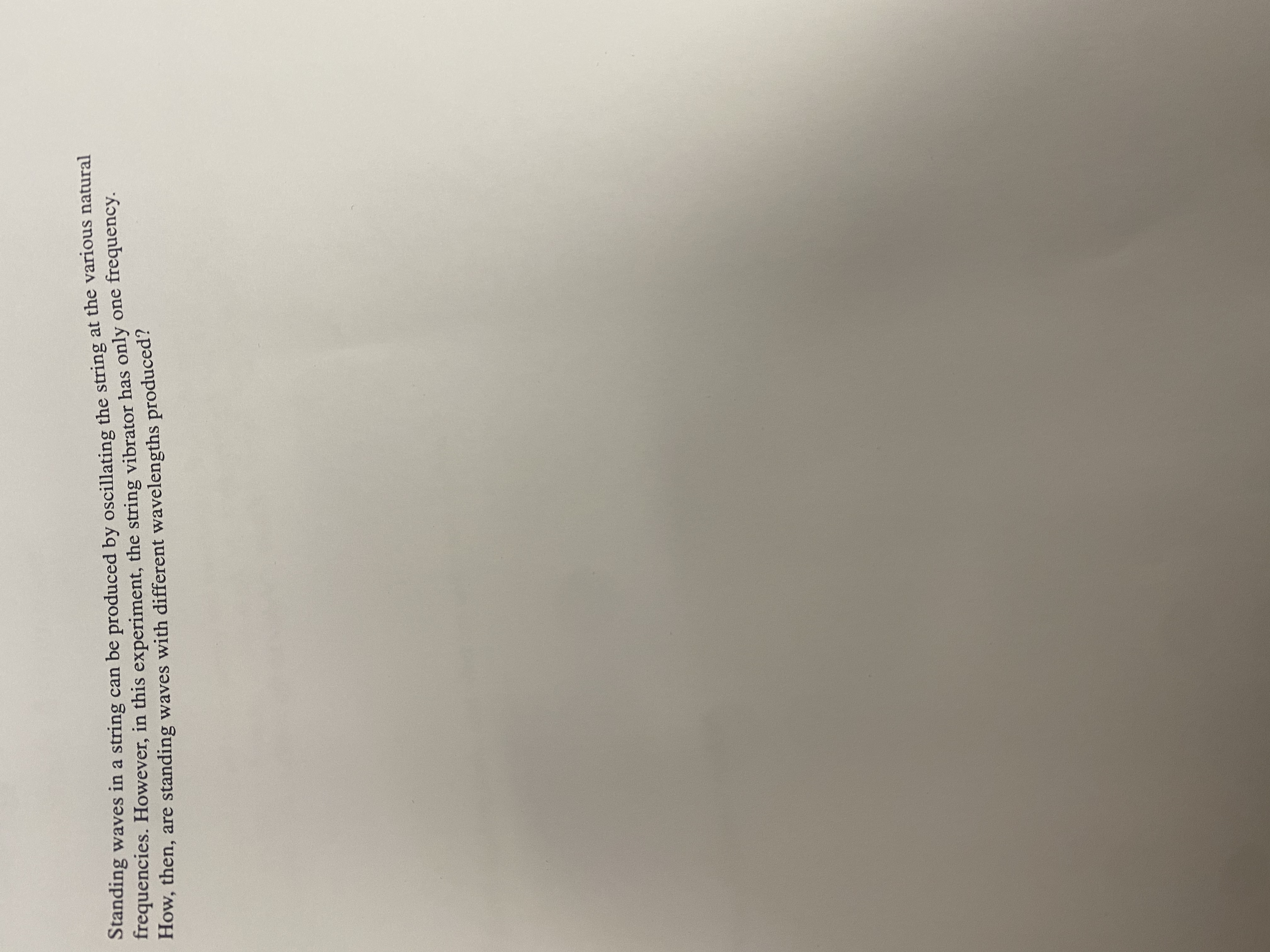
College Physics
11th Edition
ISBN: 9781305952300
Author: Raymond A. Serway, Chris Vuille
Publisher: Cengage Learning
expand_more
expand_more
format_list_bulleted
Concept explainers
Question

Transcribed Image Text:Standing waves in a string can be produced by oscillating the string at the various natural
frequencies. However, in this experiment, the string vibrator has only one frequency.
How, then, are standing waves with different wavelengths produced?
Expert Solution
This question has been solved!
Explore an expertly crafted, step-by-step solution for a thorough understanding of key concepts.
This is a popular solution
Trending nowThis is a popular solution!
Step by stepSolved in 3 steps

Knowledge Booster
Learn more about
Need a deep-dive on the concept behind this application? Look no further. Learn more about this topic, physics and related others by exploring similar questions and additional content below.Similar questions
- One end of a string is vibrated harmonic up and down by a vibrator with a frequency of 10 Hz and an amplitude of 6 cm, so that the vibration propagates to the right along a long rope with a speed of 20 m/s. If the vibrating source vibrates for the first time, determine: a) the general equation for the deviation of the wave!arrow_forwardWhat is the speed of a transverse wave on the rope if the mass were increased to 3.00 kg? What is the wavelength of a transverse wave on the rope if the mass were increased to 3.00 kg?arrow_forwardA string with a mass of 0.02 kg and a length of 2 meters is stretched between two fixed points. The tension in the string is 100 N. Calculate the speed of a transverse wave traveling through the string. (Note: Assume the string is massless, and there is no damping or energy loss during wave propagation.)arrow_forward
- A string is 1.5 m long and the wave travels at 250 m/s on the string. 1) What's the fundamental wavlength of the wave on a string? 2) What is the fudamental frequency? 3) What is the frequency of the fourth harmonic?arrow_forwardHarmonic, sinusiodal wave propagates through a string with speed v and frequency f. At a given instant of time, two points on the string have a phase difference of π/8 rad. Calculate the distance between those two pointarrow_forwardA nylon string fixed at both ends vibrates with a fundamental frequency of 196 Hz. Which of the following would have a higher fundamental frequency than this string? An indentical string that is longer. A nylon string with twice the diameter, but the same length. An indentical string that is tightened to a higher tension. An identical string that is given a larger amplitude of vibration.arrow_forward
- A transverse sinusoidal wave is moving along a string in the positive direction of an x axis with a speed of 83 m/s. At t = 0, the string particle at x = 0 has a transverse displacement of 4.0 cm from its equilibrium position and is not moving. The maximum transverse speed of the string particle at x = 0 is 16 m/s. (a) What is the frequency of the wave? (b) What is the wavelength of the wave? If the wave equation is of the form y(x, t) = ym sin(kx ±wt + q), what are (c) ym, (d) k, (e) w, (f) 4, and (g) the correct choice of sign in front of w?arrow_forwardA string has a mass attached to it as shown in the figure. The length of the entire string is 2.4 m, and its mass is 12 gram. The hanging mass attached to the string is M = 4 kg. 1/4 of the length of the string is in the hanging part (vertical) and 3/4 is parallel to the table. The string in the horizontal part is plucked, and standing waves are observed in the third harmonic. Calculate the frequency of vibrations in the string (in Hz), and what will be the speed of the wave in the string? Enter the speed in m/s as your answer in canvas. |M kgarrow_forward
arrow_back_ios
arrow_forward_ios
Recommended textbooks for you
 College PhysicsPhysicsISBN:9781305952300Author:Raymond A. Serway, Chris VuillePublisher:Cengage Learning
College PhysicsPhysicsISBN:9781305952300Author:Raymond A. Serway, Chris VuillePublisher:Cengage Learning University Physics (14th Edition)PhysicsISBN:9780133969290Author:Hugh D. Young, Roger A. FreedmanPublisher:PEARSON
University Physics (14th Edition)PhysicsISBN:9780133969290Author:Hugh D. Young, Roger A. FreedmanPublisher:PEARSON Introduction To Quantum MechanicsPhysicsISBN:9781107189638Author:Griffiths, David J., Schroeter, Darrell F.Publisher:Cambridge University Press
Introduction To Quantum MechanicsPhysicsISBN:9781107189638Author:Griffiths, David J., Schroeter, Darrell F.Publisher:Cambridge University Press Physics for Scientists and EngineersPhysicsISBN:9781337553278Author:Raymond A. Serway, John W. JewettPublisher:Cengage Learning
Physics for Scientists and EngineersPhysicsISBN:9781337553278Author:Raymond A. Serway, John W. JewettPublisher:Cengage Learning Lecture- Tutorials for Introductory AstronomyPhysicsISBN:9780321820464Author:Edward E. Prather, Tim P. Slater, Jeff P. Adams, Gina BrissendenPublisher:Addison-Wesley
Lecture- Tutorials for Introductory AstronomyPhysicsISBN:9780321820464Author:Edward E. Prather, Tim P. Slater, Jeff P. Adams, Gina BrissendenPublisher:Addison-Wesley College Physics: A Strategic Approach (4th Editio...PhysicsISBN:9780134609034Author:Randall D. Knight (Professor Emeritus), Brian Jones, Stuart FieldPublisher:PEARSON
College Physics: A Strategic Approach (4th Editio...PhysicsISBN:9780134609034Author:Randall D. Knight (Professor Emeritus), Brian Jones, Stuart FieldPublisher:PEARSON

College Physics
Physics
ISBN:9781305952300
Author:Raymond A. Serway, Chris Vuille
Publisher:Cengage Learning

University Physics (14th Edition)
Physics
ISBN:9780133969290
Author:Hugh D. Young, Roger A. Freedman
Publisher:PEARSON

Introduction To Quantum Mechanics
Physics
ISBN:9781107189638
Author:Griffiths, David J., Schroeter, Darrell F.
Publisher:Cambridge University Press

Physics for Scientists and Engineers
Physics
ISBN:9781337553278
Author:Raymond A. Serway, John W. Jewett
Publisher:Cengage Learning

Lecture- Tutorials for Introductory Astronomy
Physics
ISBN:9780321820464
Author:Edward E. Prather, Tim P. Slater, Jeff P. Adams, Gina Brissenden
Publisher:Addison-Wesley

College Physics: A Strategic Approach (4th Editio...
Physics
ISBN:9780134609034
Author:Randall D. Knight (Professor Emeritus), Brian Jones, Stuart Field
Publisher:PEARSON